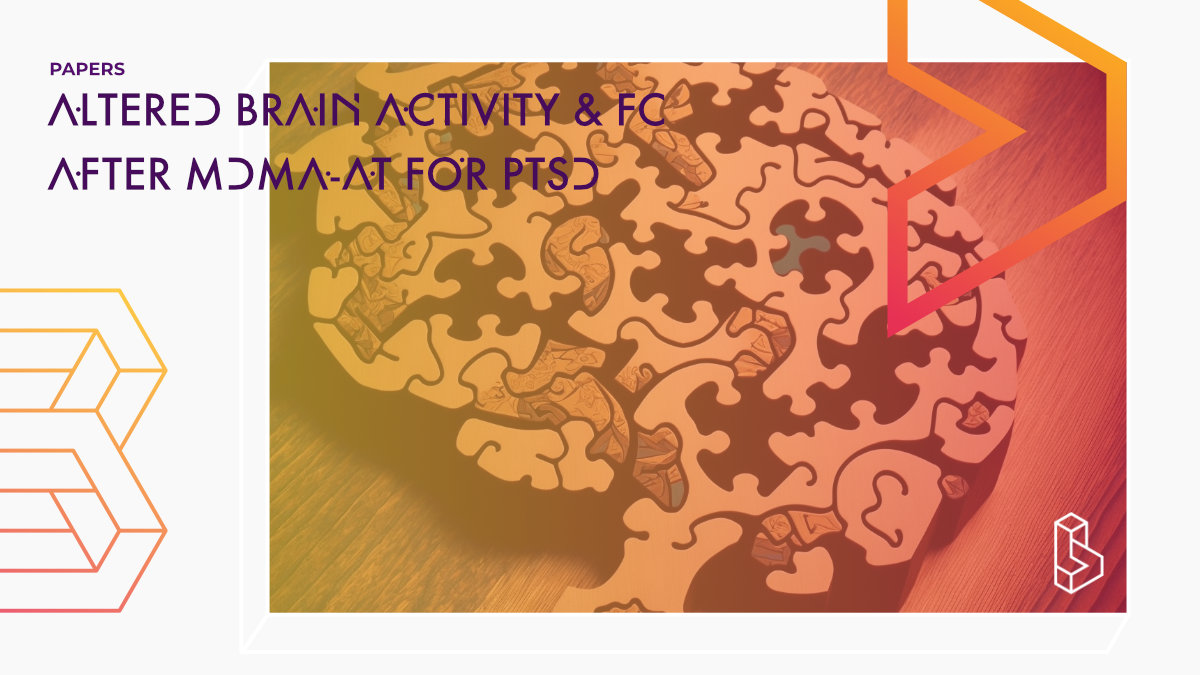This follow-up analysis (n=9), of fMRI data from veterans and first responders who underwent MDMA-assisted therapy (3x 100-125mg) for PTSD, finds a correlation between reductions in PTSD and 1) increased amygdala-hippocampal connectivity, and 2) reduced amygdala-precuneus connectivity during memory recall.
Abstract
“Introduction: 3,4-methylenedioxymethamphetamine-assisted therapy (MDMA-AT) for post-traumatic stress disorder (PTSD) has demonstrated promise in multiple clinical trials. MDMA is hypothesized to facilitate the therapeutic process, in part, by decreasing fear response during fear memory processing while increasing extinction learning. The acute administration of MDMA in healthy controls modifies recruitment of brain regions involved in the hyperactive fear response in PTSD such as the amygdala, hippocampus, and insula. However, to date there have been no neuroimaging studies aimed at directly elucidating the neural impact of MDMA-AT in PTSD patients.
Methods: We analyzed brain activity and connectivity via functional MRI during both rest and autobiographical memory (trauma and neutral) response before and two-months after MDMA-AT in nine veterans and first-responders with chronic PTSD of 6 months or more.
Results: We hypothesized that MDMA-AT would increase amygdala-hippocampus resting-state functional connectivity, however we only found evidence of a trend in the left amygdala—left hippocampus (t = –2.91, uncorrected p = 0.0225, corrected p = 0.0901). We also found reduced activation contrast (trauma > neutral) after MDMA-AT in the cuneus. Finally, the amount of recovery from PTSD after MDMA-AT correlated with changes in four functional connections during autobiographical memory recall: the left amygdala—left posterior cingulate cortex (PCC), left amygdala—right PCC, left amygdala—left insula, and left isthmus cingulate—left posterior hippocampus.
Discussion: Amygdala—insular functional connectivity is reliably implicated in PTSD and anxiety, and both regions are impacted by MDMA administration. These findings compliment previous research indicating that amygdala, hippocampus, and insula functional connectivity is a potential target of MDMA-AT, and highlights other regions of interest related to memory processes. More research is necessary to determine if these findings are specific to MDMA-AT compared to other types of treatment for PTSD.”
Authors: S. Parker Singleton, Julie B. Wang, Michael Mithoefer, Colleen Hanlon, Mark S. George, Annie Mithoefer, Oliver Mithoefer, Allison R. Coker, Berra Yazar-Klosinski, Amy Emerson, Rick Doblin & Amy Kuceyeski
Summary of Altered brain activity & FC after MDMA-AT for PTSD
Post-traumatic stress disorder (PTSD) can arise following exposure to a traumatic event or repeated stressful events and is a debilitating social and economic burden on individuals and their families. PTSD is associated with increased fear response and distressing re-experiencing of traumatic memories that often serve as a barrier to the therapeutic process.
MDMA-assisted therapy may be a viable treatment for PTSD, as it reduces the fear response associated with re-experiencing traumatic memories and enhances fear extinction in mice. MDMA may also aid the therapeutic process by enabling patient access to emotionally challenging material and facilitating memory reconsolidation/fear extinction processes.
Find this paper
https://doi.org/10.1101/2022.05.25.22275473
Open Access | Google Scholar | Backup | 🕊
Study details
Compounds studied
MDMA
Topics studied
PTSD
Neuroscience
Study characteristics
Re-analysis
Participants
9
Humans
Authors
Authors associated with this publication with profiles on Blossom
Michael MithoeferMichael Mithoefer is a psychiatrist and a Clinical Investigator and acting Medical Director of MAPS Public Benefit Corporation.
Rick Doblin
Rick Doblin Ph.D. is the founder of MAPS. His persistent work since 1986 has been one of the main drivers behind why psychedelics (including MDMA) are now coming back to therapy.
Institutes
Institutes associated with this publication
MAPS PBCMAPS Public Benefit Corporation (MAPS PBC) is the 'benefit above profit' corporation that is fully owned by MAPS.
Compound Details
The psychedelics given at which dose and how many times
MDMA 100 - 125mg | 3x
Linked Research Papers
Notable research papers that build on or are influenced by this paper
3,4-methylenedioxymethamphetamine (MDMA)-assisted psychotherapy for post-traumatic stress disorder in military veterans, firefighters, and police officers: a randomised, double-blind, dose-response, phase 2 clinical trialThis Phase II clinical trial (n=26) finds that MDMA-assisted psychotherapy (75-125 mg) led to significant and sustained decreases in PTSD (CAPS-IV) scores as compared to an active placebo (30 mg). At the 12-month follow-up, the average CAPS-IV score had dropped from 87 to 39 (67% no longer qualified for PTSD diagnosis).
Linked Clinical Trial
Exploring Mechanisms of Action in MDMA-assisted Psychotherapy for PTSDThis study measures biological and psychological processes that might help researchers to better understand what is taking place during low or medium dose and full dose MDMA-assisted psychotherapy treatment in people with PTSD.

